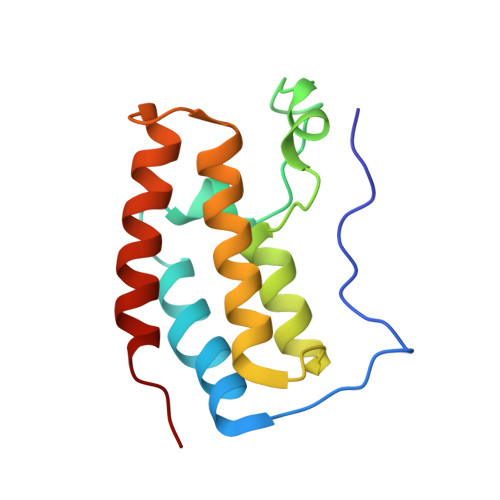Fragment-Based Drug Discovery of 2-Thiazolidinones as Inhibitors of the Histone Reader BRD4 Bromodomain.
Zhao, L., Cao, D., Chen, T., Wang, Y., Miao, Z., Xu, Y., Chen, W., Wang, X., Li, Y., Du, Z., Xiong, B., Li, J., Xu, C., Zhang, N., He, J., Shen, J.(2013) J Med Chem 56: 3833-3851
- PubMed: 23530754
- DOI: https://doi.org/10.1021/jm301793a
- Primary Citation of Related Structures:
4HXK, 4HXL, 4HXM, 4HXN, 4HXO, 4HXP, 4HXR, 4HXS - PubMed Abstract:
Recognizing acetyllysine of histone is a vital process of epigenetic regulation that is mediated by a protein module called bromodomain. To contribute novel scaffolds for developing into bromodomain inhibitors, we utilize a fragment-based drug discovery approach. By successively applying docking and X-ray crystallography, we were able to identify 9 fragment hits from diffracting more than 60 crystals. In the present work, we described four of them and carried out the integrated lead optimization for fragment 8, which bears a 2-thiazolidinone core. After several rounds of structure guided modifications, we assessed the druggability of 2-thiazolidinone by modulating in vitro pharmacokinetic studies and cellular activity assay. The results showed that two potent compounds of 2-thiazolidinones have good metabolic stability. Also, the cellular assay confirmed the activities of 2-thiazolidinones. Together, we hope the identified 2-thiazolidinone chemotype and other fragment hits described herein can stimulate researchers to develop more diversified bromodomain inhibitors.
Organizational Affiliation:
Department of Medicinal Chemistry, State Key Laboratory of Drug Research, Shanghai Institute of Materia Medica, Chinese Academy of Sciences , 555 Zuchongzhi Road, Shanghai 201203, China.















